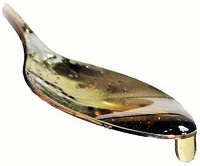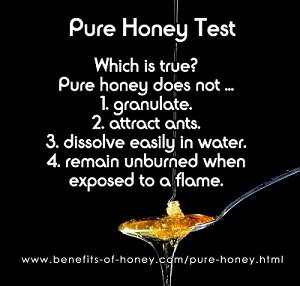
Are These 4 Ways of Testing for 100% Pure Honey Valid?
How can we differentiate 100% pure honey and adulterated honey without sending samples to the food laboratories for expensive authenticity tests and analyses?
There is a rising number of visitors to Benefits of Honey writing to me and asking this question. Unfortunately, I don't really have a clear answer to this, but would like to share my experience and thoughts about this issue from a honey consumer perspective.
The term "adulterated honey" implies that the honey has been added glucose, dextrose, molasses, corn syrup, sugar syrup, invert sugar, flour, starch, or any other similar product, other than the floral nectar gathered, processed, and stored in the comb by honey bees. Legal standards and requirements for foods, including honey quality, and tests for honey adulteration vary widely amongst countries and some may not meet the wish of every consumer around the world.
Buying Pure Honey
Personally, when selecting honey in the shop, I think it's almost impossible to tell the bad from the good by just looking at the honey content through the jar or studying its food and nutrition labels. My take is always -- go for the trusted or better known brands. The best is to be able to ask the source or supplier of the honey questions about the honey origin and how the honey is harvested and processed to get an assurance on the quality. However, this is not always possible when we do not have direct access to bee farms and beekeepers.

For commercial honey, we all know that a "pure honey" label doesn't guarantee at all that it is not diluted with water and further sweetened with corn syrup; it just promises that there is real pure honey inside, with no suggestion of its amount. The law does not require a "pure honey" label to say how much pure honey is in the bottle (National Honey Board, Honey Labeling). Also, prices are not always a good indication of quality honey. In food fraud cases, which happen a lot with Chinese honey, manufacturers can mix different honey floral blends and sell it as more expensive varieties such as Manuka honey. And so-called "local honey" may not be locally produced and processed local honey but cheap, low quality honey imported from other countries and then bottled and distributed locally.
1. Honey Granulation
A common misconception is that granulated or crystallized honey is proof of adulteration with sugar water. The truth is honey is a supersaturated sugar solution and can granulate whether or not it has been adulterated, so crystallization is normal, especially in temperate climates. Furthermore, some honey from certain floral sources is especially prone to crystallization. Buying honey in the comb is one way to assure ourselves of a quality product. Comb honey is sealed in the hive by the bees; therefore consumers can be confident that the honey has not been adulterated with sugar water. However, to boost honey production, some beekeepers feed their bees with sugar syrup so that the bees can convert the syrup to "honey". Do such practices have any implications on why some honey appears to be very clear and runny, just like syrup?
2. Do Ants Fancy Pure Honey?
Some of my web visitors strongly believe and teach that ants don't fancy pure honey and will not hover around it. It's hard to understand or believe this as there seems to be no reason why ants should favour processed sugar over honey and ants may not always be "available" at all places for a honey assessment ("no ants observed" may not necessarily mean pure honey). The reason why a sweet liquid is more attractive than another for the ants could also be due to other factors such as liquid density, flavors which vary depending on the floral types.
3. The Flame Test
Another test that is commonly discussed over the internet is the flame test which involves lighting up a cotton bud dipped into the honey with a match-stick flame. It's believed that the honey will burn if it's pure. I have tried this method many times using different types of honey, some of which I was very sure they're pure honey (e.g honeycomb honey), but the result I got was never consistent, and it seemed to depend very much on how much honey was dipped and how long the honey was exposed to the flame.

4. Ease of Dissolving in Water
There's another simple way which I have tried to verify the purity of honey: Observe how liquid honey comes down into a glass of water. It is believed that pure honey does not immediately dissolve in water; it takes a bit of effort to stir it in the water to dissolve the lumpy bits, whereas honey adultereated with sugar tends to dissolve easily in a jiggery when it is dropped into the water. However, test result is sometimes not that clear because different honey varieties have different viscosity, some are denser and thicker than others, for instance, obviously honey in cream form, even if it's adulterated with other substance, will not dissolve as easy as liquid honey in water.
It is suggested that people who are used to tasting honey may be easier to detect any added sugar. But frankly, because there are just too many floral varieties and blends, and the amount of adulteration may not be sufficient to affect the taste and aroma of the honey, even though I frequently take honey, I am still not 100% certain about my suspicion sometimes.
The Verdict
Hence, all the tests discussed above are not foolproof. It's hard to be really absolutely sure about honey authenticity, unless from home you can use a refractometer to check the moisture content (Wikipedia) or perform scientific laboratory tests like spectroscopy, a method that uses the principle of interaction of light with mater to differentiate substances or conduct carbon isotope ratios analysis to determine if sugars were added to the honey (don't bother if these jargons sound totally bizarre; as a consumer, I am not familiar with them either). Nevertheless, from all the verification ways that are discussed above (labels, pouring, dissolving honey, etc) if you have reasons to suspect that the honey is diluted and corn syrup has been added, my stance is - stay away from those brands. Better to err on the side of caution than to be sorry...well, you most probably won't fall sick by taking the adulterated honey, but you know adulteration with cheaper sugars brings down the natural value of the honey and this doesn't help in justifying for the amount of money you pay.
And meanwhile, if any of you, honey lovers, honey connoisseurs, beekeepers, or anyone has a reliable method to test pure honey from home (without the use of industrial chemicals), why not just share with us by posting it below!
Other Related Pages
1. Does everyone have the same definition and expectations of pure honey? Find out in: "What is Pure Honey? (1-Question Survey)".
2. What is good quality honey? Here are several factors for consideration: "What's Considered Good Quality Honey".
3. This bubbling test has been suggested by many honey aficionados and beekeepers, so let us see how convincing the results are: Test for Real Honey - Bubbling Test.
Post & Share Your Method of Testing For Pure Honey
PS: Give your posting some time to load and be published in Testing for 100% Pure Honey - Latest Postings. We've not made it work automatically due to spamming concerns.
Read Postings - My Method of Testing for Pure Honey
Testing for 100% Pure Honey - Latest Postings
Testing for 100% Pure Honey 2015-2016
Testing for 100% Pure Honey 2014
Testing for 100% Pure Honey 2013
Testing for 100% Pure Honey 2012
Testing for 100% Pure Honey 2011
Testing for 100% Pure Honey 2008 to 2010